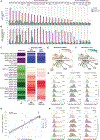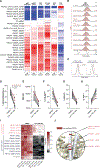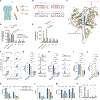Scalable generation and functional classification of genetic variants in inborn errors of immunity to accelerate clinical diagnosis and treatment
- PMID: 40543502
- PMCID: PMC12514753
- DOI: 10.1016/j.cell.2025.05.037
Scalable generation and functional classification of genetic variants in inborn errors of immunity to accelerate clinical diagnosis and treatment
Abstract
Next-generation sequencing is pivotal for diagnosing inborn errors of immunity (IEI) but predominantly yields variants of uncertain significance (VUS), creating clinical ambiguity. Activated PI3Kδ syndrome (APDS) is caused by gain-of-function (GOF) variants in PIK3CD or PIK3R1, which encode the PI3Kδ heterodimer. We performed massively parallel base editing of PIK3CD/PIK3R1 in human T cells and mapped thousands of variants to a clinically important readout (phospho-AKT/S6), nominating >100 VUS and unannotated variants for functional classification and validating 27 hits. Leniolisib, an FDA-approved PI3Kδ inhibitor, rescued aberrant signaling and dysfunction in GOF-harboring T cells and revealed partially drug-resistant PIK3R1 hotspots that responded to novel combination therapies of leniolisib with mTORC1/2 inhibition. We confirmed these findings in T cells from APDS patients spanning the functional spectrum discovered in the screen. Integrating our screens with population-level genomic studies revealed that APDS may be more prevalent than previously estimated. This work exemplifies a broadly applicable framework for removing ambiguity from sequencing in IEI.
Keywords: APDS; CRISPR base editing; VUS; activated PI3K delta syndrome; clinical NGS; genome engineering; inborn errors of immunity; precision medicine; primary T cells; variant classification.
Copyright © 2025 Elsevier Inc. All rights reserved.
Conflict of interest statement
Declaration of interests B.I. and J.D.M. received research support from Pharming. B.I. is a consultant for or has received honoraria from Volastra Therapeutics, Johnson & Johnson/Janssen, Novartis, GSK, EISAI, AstraZeneca, and Merck and has received research funding to Columbia University from Agenus, Alkermes, Arcus Biosciences, Checkmate Pharmaceuticals, Compugen, Immunocore, Regeneron, and Synthekine. J.D.M. is on the scientific advisory board for Blueprint Medicine and receives grant funding from Pharming.
Figures







References
-
- Al-Mousa H, Abouelhoda M, Monies DM, Al-Tassan N, Al-Ghonaium A, Al-Saud B, Al-Dhekri H, Arnaout R, Al-Muhsen S, Ades N, et al. (2016). Unbiased targeted next-generation sequencing molecular approach for primary immunodeficiency diseases. J. Allergy Clin. Immunol 137, 1780–1787. 10.1016/j.jaci.2015.12.1310. - DOI - PubMed
-
- Cifaldi C, Brigida I, Barzaghi F, Zoccolillo M, Ferradini V, Petricone D, Cicalese MP, Lazarevic D, Cittaro D, Omrani M, et al. (2019). Targeted NGS platforms for genetic screening and gene discovery in primary Immunodeficiencies. Front. Immunol 10, 316. 10.3389/fimmu.2019.00316. - DOI - PMC - PubMed
MeSH terms
Substances
Supplementary concepts
Grants and funding
LinkOut - more resources
Full Text Sources
Miscellaneous

